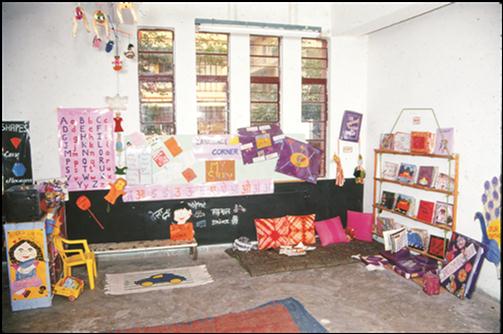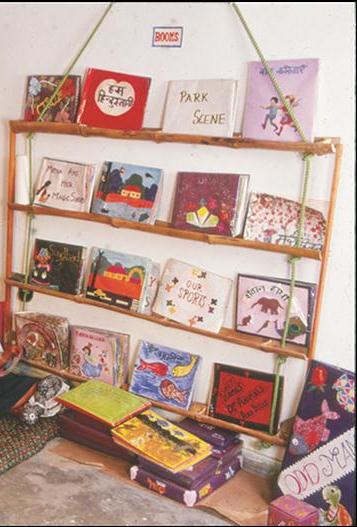2 Making a book area
In Case Study 2, a teacher takes steps to improve the classroom reading environment.
Case Study 2: Mrs Shanta makes a book area
Mrs Shanta is a primary school teacher of Class V in a co-educational government school.
Most of the students in my class don’t have any books at home. Although my students had the opportunity to borrow books from the school library once a week during the library period, they were not very interested in reading.
I examined my classroom. It had very few books for my students to read. Moreover, because these few books were kept inside a cupboard, they were often not visible. I decided to try making some changes.
First I increased the number of books in the classroom. I asked my colleagues for any surplus books. I decided to spend all my annual allowance for purchasing teaching and learning materials on books. I bought many interesting, inexpensive books from the National Book Trust and Children’s Book Trust. With the help of my students, I also made some story books using notebooks and magazine pictures.
While selecting and making the books, I tried to make them appealing to my students. I included picture books, easy-to-read books for early readers, fables and folk tales, information books, jokes and riddle books, poetry books, comics (including Spiderman), books on sports, and books on making things. I also borrowed children’s magazines from the school library. I avoided preachy, ‘moral’ stories, since from experience I knew they put off students. However, I did take care to choose some stories that convey important messages. For example, there is a Children’s Book Trust’s publication about the problems of a tribal boy on his first few days at school due to the insensitivity of other students and the teacher, and another book about a student being bullied for stammering.
My next task was to create a ‘mini-library’ in the corner in my classroom, with shelves and a reading area. I asked my students’ advice as to where this might be. Initially they felt that the room was too small to accommodate this, but when we rearranged all the furniture we were surprised that everything could fit in.
I placed a mat in the library corner because most of the students found it more comfortable to read while sitting on the floor. I obtained some attractive posters, free from book sellers, to encourage reading. A chair provided a place for me or one of the students to read aloud to the other students (Figure 1).
Figure 1 Mrs Shanta’s class library.
The students referred to the corner as a special place. The book corner gave them the message that books are so valued that space should be taken from the rest of classroom to make room for them. The students asked for more time to use the corner and permission to eat while reading the books.
Pause for thought
|
Activity 2: Look around your classroom – a planning activity
Look around your classroom and think about how you could arrange the space and furniture to make a small class library in a corner, as in Figure 2. Make a list of:
- books you can get from the local library
- books you can make
- magazines or newspapers you can get from other teachers, friends and family
- posters about books
- any other reading materials.
Figure 2 An example of a class book area.
Talk to other teachers about how you could work together to create shared resources for reading.
See Resource 1, ‘Involving all’, to learn more about developing resources for a range of interests and abilities.
1 Providing a reading environment


